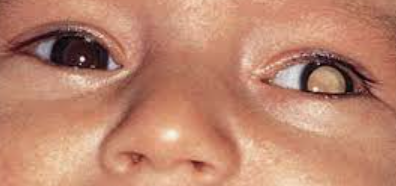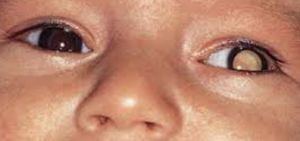Retinoblastoma occurs in 1 in 20,000 children, making it the 10th most common pediatric cancer.
Retinoblastoma is a rare form of eye cancer that develops in the retina – the sensitive lining on the back of the eye.
Early eye exams are important for diagnosis and treatment. Retinoblastoma may be cured, especially when diagnosed early.
What causes retinoblastoma?
Retinoblastoma usually affects babies, infants and young children, though it may affect adults. Retinoblastoma occurs when nerve cells in the retina develop genetic mutations.
Normally, the cells in the retina stop dividing when they become mature retinal cells. The genetic mutations cause the cells to continue to grow and multiply, forming a tumor, known as retinoblastoma.
Retinoblastoma cancer cells have the ability to penetrate deeper into the eye and surrounding structures. This type of cancer has the potential to spread to other parts of the body, such as the brain and spine.
In most cases, the source of the actual genetic mutation that causes retinoblastoma is not clear. However, it is well understood that children will inherit this condition from their parents.
What are the symptoms of retinoblastoma?
Since retinoblastoma mostly affects infants and young children, symptoms are difficult to notice, so it is important for parents to be aware of the signs. The symptoms of retinoblastoma include:
- Whitish color in the pupil of the eye, seen when light is shone in the eye
- Poor vision
- Eye swelling
- Eye redness
- Eyes that appear to be looking in different directions
If your child displays any of these symptoms, contact an eye doctor near you.
SEE RELATED: 7 Common Pediatric Eye Conditions
How is retinoblastoma treated?
Treatment for retinoblastoma depends on the tumor and whether the cancer has spread to other areas. The goal of treatment is to save vision whenever possible.
Chemotherapy
Chemotherapy is a drug treatment that kills cancer cells by causing chemicals to travel throughout the body. Chemotherapy can help reduce a tumor so that the residual cancer cells can be treated with other treatments.
Chemotherapy can also be used to treat cancer that has progressed to other parts of the body.
Radiation therapy
Radiation therapy uses targeted beams of energy to kill cancer cells. To eliminate tumor cells, a small disk of radioactive material is sometimes inserted in or near the tumor and is left in place for some time.
In other circumstances, the tumor is treated with radiation using a large machine that beams energy from outside the body.
Cold treatments (cryotherapy)
Cancer cells are frozen using a very cold material such as liquid nitrogen. The chemical is withdrawn once the cells have frozen, and the cells defrost. The freezing and thawing process is repeated, destroying cancer cells each time.
Heat treatments (thermotherapy)
Cancer cells are killed by exposing them to extreme heat.
Laser therapy
To destroy blood vessels that feed the tumor, a laser may be used, killing the cancer cells.
Surgery (enucleation)
If a tumor has become too large for other treatments, surgery to remove the eyeball may be required. This may prevent the cancer from spreading to other parts of the body.
The surgeon removes the eyeball and replaces it with an artificial eye implant in the eye socket. This implant is connected to the muscles of the eye. The eye muscles will eventually move this eyeball in the same way they moved the original eye. However, the implanted eyeball cannot see.
Despite becoming blind in the affected eye, most children adjust extremely well over time. In many circumstances, the presence of an artificial eye will be undetectable.
Early eye exams are important for diagnosis and treatment. Retinoblastoma may be cured, especially when diagnosed early.
LEARN MORE: Guide to Pediatric Eye Conditions
If you have any concerns on the appearance of your child’s eyes, schedule an eye exam with an eye doctor near you who can diagnose and recommend treatment for your child.


